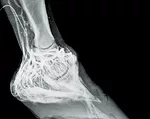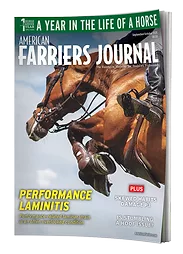Advertise Follow Us
American Farriers Journal

View Archived Issues
December 2015
Volume: 41
Edition: 8
American Farriers Journal is the “hands-on” magazine for professional farriers, equine veterinarians and horse care product and service buyers.
-
Table Of Contents
Table Of Contents
Are You Practicing Legally?
Arkansas farrier and lawmaker helped to change the veterinary practice act after he discovered horseshoeing banRead MoreShoeing for a LivingFootcare by Committee
A gathering of farriers in western Pennsylvania provides opportunity to discuss each other’s approach to hoof careRead MoreShoeing for Stifle Conditions
Accurate vet diagnosis and correct farriery principles can help ease pelvic limb lamenessRead MoreThoughts on Defining the “Good” Foot
Approaching the concept of a “normal” foot led to an exercise in thinking about the elusive “good” footRead MoreBooknotes: Recollections From 202 Years Of Family Shoeing
Sparks From The Smiddy, The Life Of A World Champion Farrier By David Wilson as told to Andrew ArbuckleRead MoreIt All Started Because Someone Wanted To Show Off A Shoeing Truck
And 38 years later, Danny Ward’s Eastern Farrier Conference is still spreading the word on hoof-care educationRead MoreFarrier Q&A: November 2015
When you get ready to trim and place the next set of shoes on a horse, how much do you rely on reading the actual amount of wear on the existing shoes? What do you look for and how do you use this info in deciding how best to shoe the horse?Read MorePreventing And Addressing Hoof Flares
Identifying and correctly managing deformations are critical to keeping horses soundRead MoreA Hands-On Approach To Sharpening Your Hoof Knife
A multi-step process may be old school, but results in a sharpened knifeRead MoreNothing Goes to Waste in This Farrier’s Shop
For this instructor, the most important lesson in his shop is to think outside the box when at the forgeRead MorePricing for Success
California farrier offers valuable tips for how you should be charging your clientsRead MoreAre You Choosing The Right Nail?
A wider selection means better options for your shoeing jobRead MoreQuick Tips for Improving Your Bottom Line
British farrier David Nicholls shares his thoughts on making the business side of farriery more pleasantRead MoreImprove Eyesight and Prevent Slippage with Specialty Specs
Clic reading glasses keep specs in place with an adjustable wrap-around neckband and magnetic breakaway bridgeRead MoreBalancing The Foot With The Golden Ratio
Minnesota farrier develops protocol to aid understanding of the hoofRead MoreFarrier Urges American Horse Council To Back Footcare Standards
It would entail development of a program to include education, training and eventual licensing of all farriersRead MoreSpotlight on Hoof Care: Consider The Entire Horse For Better Shoeing
Clinic draws from nutrition and whole-horse examinations to find solutions for laminitic horsesRead MoreResearch Journal: December 2015
The information, ideas and opinions expressed are those of the author and do not necessarily represent those of the United States Department of Agriculture.Read More -
Featured Articles
Featured Articles
Balancing The Foot With The Golden Ratio
Minnesota farrier develops protocol to aid understanding of the hoofRead MoreShoeing for a LivingFootcare by Committee
A gathering of farriers in western Pennsylvania provides opportunity to discuss each other’s approach to hoof careRead More - Digital Edition
-
Online Extras
Online Extras
















